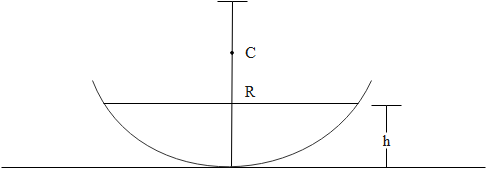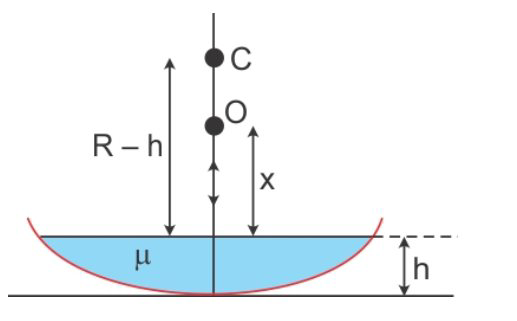
A concave mirror of radius $R$ is kept on a horizontal table. Water (refractive index $=\mu$ ) is poured into it up to a height $h$. Where should an object be placed so that its image is formed on itself?


Answer
473.1k+ views
Hint: We know that concave mirrors can produce both real and virtual images; they can be upright (if virtual) or inverted (if real); they can be behind the mirror (if virtual) or in front of the mirror (if real); they can also be enlarged, reduced, or the same size as object. A concave mirror, or converging mirror, has a reflecting surface that is recessed inward (away from the incident light). Concave mirrors reflect light inward to one focal point. They are used to focus light.
Complete step by step answer
The diagram for this question is given as:

The radius of curvature of the concave mirror is R. Water is poured up to height h.
Now, if the object is placed at the centre of curvature (C) of the mirror, then the image is formed on itself, that is on $\mathrm{C}$.
But, since water of refractive index $\mu$ is poured in it, the object should be placed closer to the surface of water than $\mathrm{C}$.
That is, the object should be placed at O. Let $x$ be the distance from the surface of water.
Now, we have
Refractive index $\mu=\dfrac{\text { Apparent depth }}{\text { Real depth }}$ $\therefore \mu=\dfrac{R-h}{x}$
$\therefore x=\dfrac{R-h}{\mu}$
Note: We know that convex Mirror is a curved mirror where the reflective surface bulges out towards the light source. This bulging out surface reflects light outwards and is not used to focus light. The image looks smaller than the object from the distance but gets larger as the object gets closer to the mirror. The upright images produced by concave mirrors (when the object is in front of F) are magnified images. And the upright images produced by plane mirrors have the same size as the object.
Complete step by step answer
The diagram for this question is given as:

The radius of curvature of the concave mirror is R. Water is poured up to height h.
Now, if the object is placed at the centre of curvature (C) of the mirror, then the image is formed on itself, that is on $\mathrm{C}$.
But, since water of refractive index $\mu$ is poured in it, the object should be placed closer to the surface of water than $\mathrm{C}$.
That is, the object should be placed at O. Let $x$ be the distance from the surface of water.
Now, we have
Refractive index $\mu=\dfrac{\text { Apparent depth }}{\text { Real depth }}$ $\therefore \mu=\dfrac{R-h}{x}$
$\therefore x=\dfrac{R-h}{\mu}$
Note: We know that convex Mirror is a curved mirror where the reflective surface bulges out towards the light source. This bulging out surface reflects light outwards and is not used to focus light. The image looks smaller than the object from the distance but gets larger as the object gets closer to the mirror. The upright images produced by concave mirrors (when the object is in front of F) are magnified images. And the upright images produced by plane mirrors have the same size as the object.
Recently Updated Pages
Glucose when reduced with HI and red Phosphorus gives class 11 chemistry CBSE

The highest possible oxidation states of Uranium and class 11 chemistry CBSE

Find the value of x if the mode of the following data class 11 maths CBSE

Which of the following can be used in the Friedel Crafts class 11 chemistry CBSE

A sphere of mass 40 kg is attracted by a second sphere class 11 physics CBSE

Statement I Reactivity of aluminium decreases when class 11 chemistry CBSE

Trending doubts
10 examples of friction in our daily life

One Metric ton is equal to kg A 10000 B 1000 C 100 class 11 physics CBSE

Difference Between Prokaryotic Cells and Eukaryotic Cells

State and prove Bernoullis theorem class 11 physics CBSE

What organs are located on the left side of your body class 11 biology CBSE

How many valence electrons does nitrogen have class 11 chemistry CBSE




